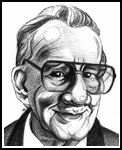Wilson Greatbatch
After earning a BS from Cornell University and a master’s degree in Electrical Engineering from the University of Buffalo and serving with the Navy in World War II, Wilson Greatbatch began working in medical research. One afternoon in the late 1950s, he was inspired by a mistake to invent one of the most significant medical devices of all time: the implantable cardiac pacemaker.
Greatbatch was building an oscillator to record heart sounds. When he accidentally installed a resistor with the wrong resistance into the unit, it began to give off a steady electrical pulse. Greatbatch realized that the small device could be used to regulate the human heart. After two years of refinements, he hand-crafted the world's first successful implantable pacemaker (patent #3,057,356). Until that time, the apparatus used to regulate heartbeat was the size of a television set and painful to use.
In 1970, Wilson Greatbatch founded Greatbatch, Inc. to develop long-lived primary batteries to fuel pacemakers.
Greatbatch later went one step further, inventing a corrosion-free lithium battery to power the pacemaker. His pacemakers and batteries have improved and saved the lives of millions of people worldwide. Thus, in 1985, the National Society of Professional Engineers named Greatbatch's invention one of the ten greatest engineering contributions to society of the last 50 years. In later years, Greatbatch turned his attention to the environment (for example, he built a solar-powered canoe) and to fighting AIDS. At the time of his death in 2011, Greatbatch had been granted over 325 patents.
In recognition of his inventions and his spirit, Wilson Greatbatch was awarded the Lemelson-MIT Lifetime Achievement Award and served as one of its invention ambassadors.


